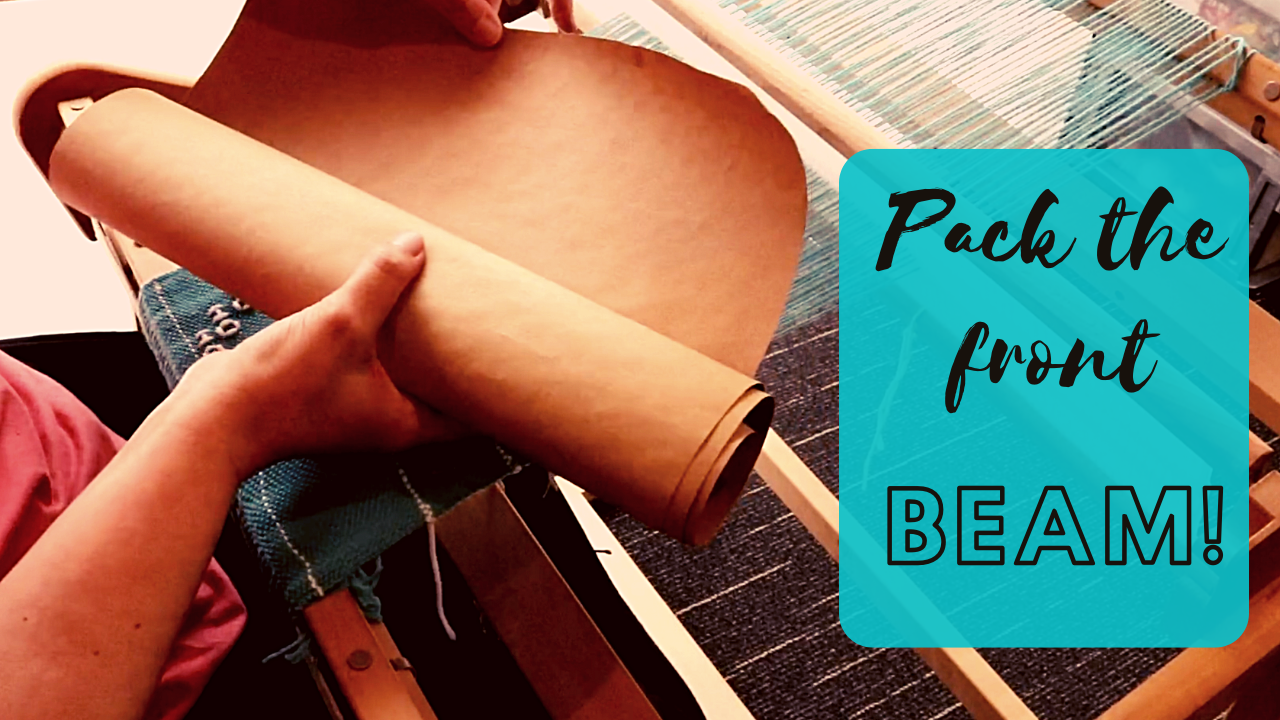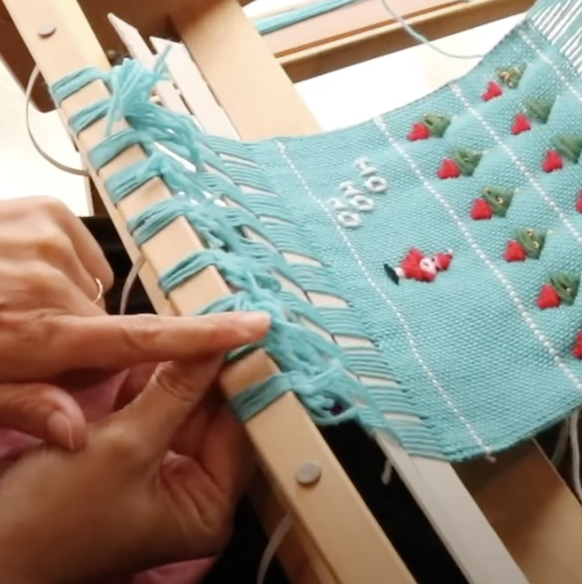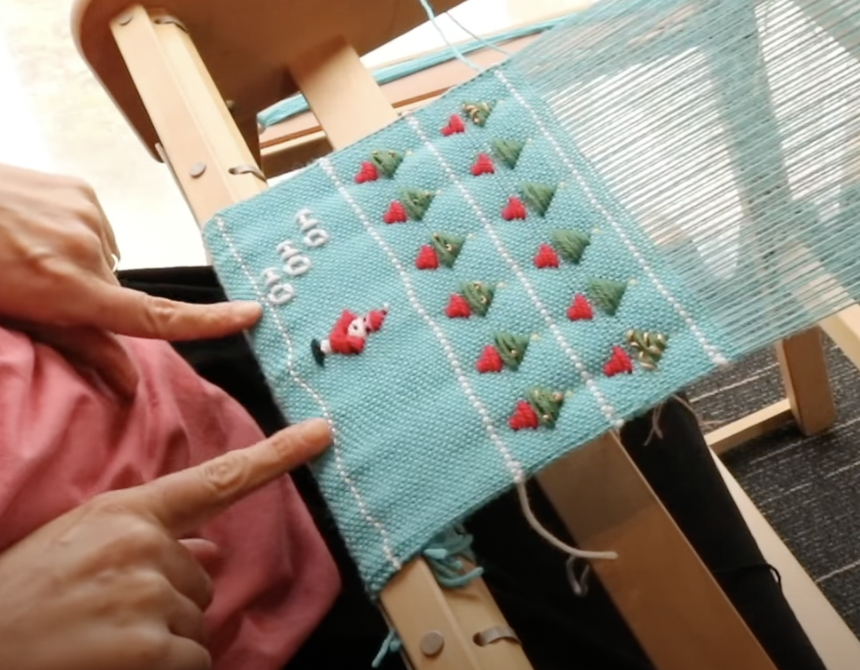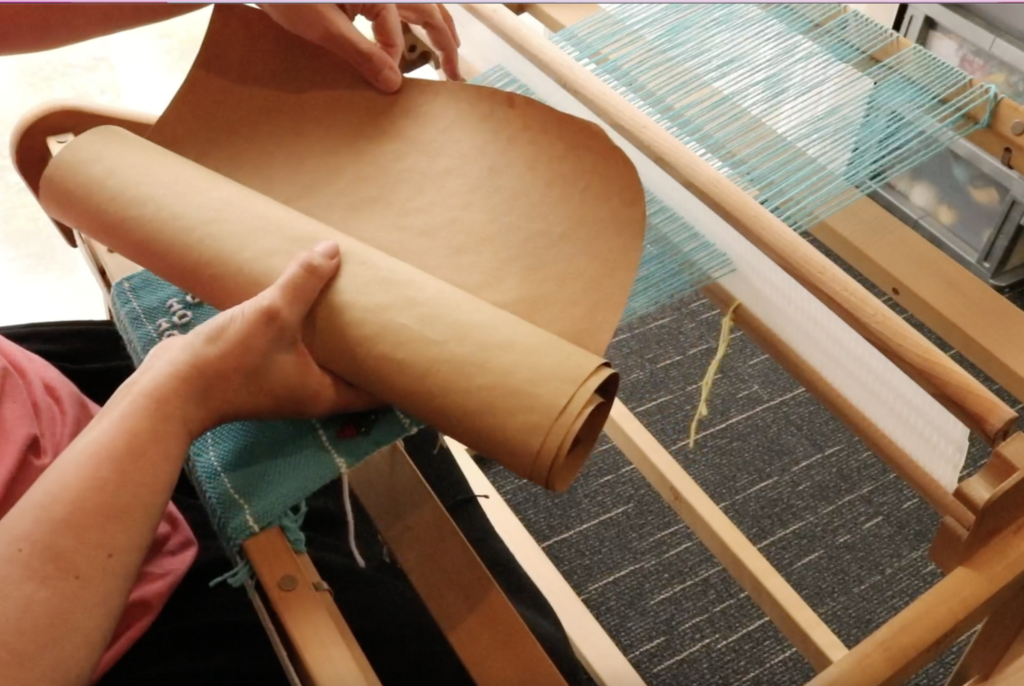When warping our rigid heddle looms, we are careful to pack the back beam as we wind on the warp. This may be done with a variety of materials, and some are more effective than others. It can be a personal preference too!
What a lot of weavers don’t seem to be so familiar with is the idea of packing the front beam. Quite often, when I’m troubleshooting with a student and I ask if they’ve packed the front beam, they seem surprised by the question. Packing the front beam? I’ve never heard of that!
*This post may contain affiliate links. For more information, please see my disclosure policy.
So, why would you want or need to pack the front beam? And what exactly do I mean by that?
Let’s start with the definition so we’re all on the same page!
Packing the front beam is simply introducing something extra to separate the warp as you weave and it begins to roll around the front beam.
Now we can look at the why. There are a couple of reasons as to why packing the front beam is a really good idea.
When you have finished warping and threading, you then need to tie or lash on your warp onto the front apron rod. Doing this results in knots or bumps on the apron rod.
As you begin to weave and advance your warp, you will reach the point where your warp is rolling around the front roller beam and onto itself. As this advancing of the warp happens, the knots, plus the apron rod ties can begin to have a detrimental effect on your weaving.
Firstly, you will likely begin to see some lumpiness at the bottom of your weaving (note that the white line of weaving that was previously straight is now a bit wavy!)
This is caused by the knots or apron ties pushing against your weaving from the underside. There are two problems with this happening:
- The raised and lowered parts cause a change in the warp tension. The bumps tighten the tension and the dents lower the tension, so you end up with slightly uneven tension.
- The worse case scenario is that your weaving is irreparably damaged because the knots or ties push the weaving apart. This can be more likely to happen when using a slippery thread like tencel, silk or bamboo, where your woven threads can move more easily, rather than something like wool, which is more “grabby” and unlikely to move out of place.
Fortunately there is a really simple solution to the problem, and that is to pack the front beam, or insert something that will separate those layers of fabric and act as a barrier between your weaving and the knots and ties.
Weavers use a variety of materials for packing, and it can really be a personal preference or what you find most effective. Initially I used the cardboard separators that came with the loom, and while they do work well, I find that the brown craft paper on a roll that I now use to be the superior choice.
What I love about the paper on a roll is that it’s thick and sturdy (a thinner paper will not work in the same way as it tends to crumple while you’re trying to advance your warp), you can purchase it to the width of your loom (or if the same width is unavailable, it’s easy to cut pieces to size) and you can use it over and over, so it’s very economical.
The roll that I bought years ago is still going strong and there is still a huge amount left.
An additional benefit of packing your front beam as you advance the warp is that your overall tension will vastly improve, and will continue to do so as you continue to weave.
I pack the front beam, whether I’m weaving on my rigid heddle, table or floor loom, it is beneficial for many types of weaving.
If you would like to see how I insert the paper roll at the front beam of my rigid heddle loom, please watch this video-
Until next time…
Happy Weaving!





Yes I was taught that from the beginning and I agree it help keep the fabric flay and avoids bumps with the knots. Have tried other methods but always have gone back to putting carboard into both aprons.
Great that it works well for you! 😊
Thanks so much for this. I have used empty paper towel rolls to cover the bumps, but I can see the use in continuing with the paper to keep the tension tight. I can’t wait to try this.
HI Kelly this is for you only and I don’t know how to get hold of you
below are some links I have used for my knitting machine. Hope these help you
Nina
singer and the old studio machines are the same, just different names
http://www.needle-tek.com/ I have purchased from and they repaired my sk 700 machine
http://eileenmontgomery.com/
http://www.ileen.com/
http://mkmanuals.com/pattern-library-for-punchcard-knitters-silver-machine-knitting-institute.html
http://mkmanuals.com/
http://theanswerlady.com/Youtubelinks.html lots of information here
Free Machine Knitting Patterns for Flat Bed and Passap | knittsings
Thanks so much Nina, I’ll be checking those out! 😀
Hi Kelly,
Thank you ever so much for this tip. I had no idea that it can be done.
Happy weaving, Happy Holidays,
Margaret
Thank you Margaret, Merry Christmas!
Thank you. I had thought about this before and will do it on my next project. I can see how it can help with a more consistent tension. My only concern is how much it will change the length of the item I will be able to weave.
It doesn’t affect the length at all Sharon, just weave as you normally would.
Many people use the cardboard tube from an empty paper towel roll cut down the middle with good results for smaller looms.
Yes, that’s right, I’ve done that too and it works well.
I have used the cardboard core from a roll of paper towels to cover up the knots. You just cut all down one side so it fits right around the knots and the beam, and completely obliterates the lumps and bumps. For a 24″ loom I use 2 side by side, or you could use the core of a roll of Christmas wrapping paper cut to size. What do you think of this? It seems to work well for me.
Yes, Helen, I’ve done the same, it works very well 😊
Thanks Kelly! I am guilty of forgetting to pack my front beam. I use the warp separators, as I learned from you, but I forget to add them ass I am advancing the warp. I have tried the paper, but I never het it even. Thus It rolls wonky. Any tips for making sure it is straight when starting out? I do like the paper better for the back beam instead of trying to catch the separators, but I can get those straight! Thanks!
Probably the important 2 factors to using the paper successfully is to:
1. Make sure you have the right thickness of paper – not too thin, not too thick.
2. Cutting your paper off the roll into shorter lengths can be helpful and ensure that it’s easier to control once on the loom.
Regarding straightness – slacken off your warp tension a little to insert the paper, then tighten up slowly to keep it in position.
I pack the front beam but only at the beginning – do you pack the whole length of the weaving?
Yes, I do Kathy, I think it really helps the overall tension as you continue to weave.